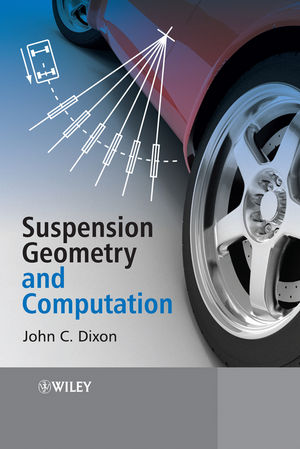Suspension Geometry and ComputationISBN: 978-0-470-51021-6
Hardcover
440 pages
December 2009
 This is a Print-on-Demand title. It will be printed specifically to fill your order. Please allow an additional 10-15 days delivery time. The book is not returnable.
|
||||||
1 Introduction and History.
1.1 Introduction.
1.2 Early Steering History.
1.3 Leaf-Spring Axles.
1.4 Transverse Leaf Springs.
1.5 Early Independent Fronts.
1.6 Independent Front Suspension.
1.7 Driven Rigid Axles.
1.8 De Dion Rigid Axles.
1.9 Undriven Rigid Axles.
1.10 Independent Rear Driven.
1.11 Independent Rear Undriven.
1.12 Trailing-Twist Axles.
1.13 Some Unusual Suspensions.
References.
2 Road Geometry.
2.1 Introduction.
2.2 The Road.
2.3 Road Curvatures.
2.4 Pitch Gradient and Curvature.
2.5 Road Bank Angle.
2.6 Combined Gradient and Banking.
2.7 Path Analysis.
2.8 Particle-Vehicle Analysis.
2.9 Two-Axle-Vehicle Analysis.
2.10 Road Cross-Sectional Shape.
2.11 Road Torsion.
2.12 Logger Data Analysis.
References.
3 Road Profiles.
3.1 Introduction.
3.2 Isolated Ramps.
3.3 Isolated Bumps.
3.4 Sinusoidal Single Paths.
3.5 Sinusoidal Roads.
3.6 Fixed Waveform.
3.7 Fourier Analysis.
3.8 Road Wavelengths.
3.9 Stochastic Roads.
References.
4 Ride Geometry.
4.1 Introduction.
4.2 Wheel and Tyre Geometry.
4.3 Suspension Bump.
4.4 Ride Positions.
4.5 Pitch.
4.5 Roll.
4.7 Ride Height.
4.8 Time-Domain Ride Analysis.
4.9 Frequency-Domain Ride Analysis.
4.10 Workspace.
5 Vehicle Steering.
5.1 Introduction.
5.2 Turning Geometry – Single Track.
5.3 Ackermann Factor.
5.4 Turning Geometry – Large Vehicles.
5.5 Steering Ratio.
5.6 Steering Systems.
5.7 Wheel Spin Axis.
5.8 Wheel Bottom Point.
5.9 Wheel Steering Axis.
5.10 Caster Angle.
5.11 Camber Angle.
5.12 Kingpin Angle Analysis.
5.13 Kingpin Axis Steered.
5.14 Steer Jacking.
References.
6 Bump and Roll Steer.
6.1 Introduction.
6.2 Wheel Bump Steer.
6.3 Axle Steer Angles.
6.4 Roll Steer and Understeer.
6.5 Axle Linear Bump and Roll Steer.
6.6 Axle Non-Linear Bump and Roll Steer.
6.7 Axle Double-Bump Steer.
6.8 Vehicle Roll Steer.
6.9 Vehicle Heave Steer.
6.10 Vehicle Pitch Steer.
6.11 Static Toe-In and Toe-Out.
6.12 Rigid Axles with Link Location.
6.13 Rigid Axles with Leaf Springs.
6.14 Rigid Axles with Steering.
References.
7 Camber and Scrub.
7.1 Introduction.
7.2 Wheel Inclination and Camber.
7.3 Axle Inclination and Camber.
7.4 Linear Bump and Roll.
7.5 Non-Linear Bump and Roll.
7.6 The Swing Arm.
7.7 Bump Camber Coefficients.
7.8 Roll Camber Coefficients.
7.9 Bump Scrub.
7.10 Double-Bump Scrub.
7.11 Roll Scrub.
7.12 Rigid Axles.
References.
8 Roll Centres.
8.1 Introduction.
8.2 The Swing Arm.
8.3 The Kinematic Roll Centre.
8.4 The Force Roll Centre.
8.5 The Geometric Roll Centre.
8.6 Symmetrical Double Bump.
8.7 Linear Single Bump.
8.8 Asymmetrical Double Bump.
8.9 Roll of a Symmetrical Vehicle.
8.10 Linear Symmetrical Vehicle Summary.
8.11 Roll of an Asymmetrical Vehicle.
8.12 Road Coordinates.
8.13 GRC and Latac.
8.14 Experimental Roll Centres.
References.
9 Compliance Steer.
9.1 Introduction.
9.2 Wheel Forces and Moments.
9.3 Compliance Angles.
9.4 Independent Suspension Compliance.
9.5 Discussion of Matrix.
9.6 Independent-Suspension Summary.
9.7 Hub Centre Forces.
9.8 Steering.
9.9 Rigid Axles.
9.10 Experimental Measurements.
References.
10 Pitch Geometry.
10.1 Introduction.
10.2 Acceleration and Braking.
10.3 Anti-Dive.
10.4 Anti-Rise
10.5 Anti-Lift.
10.6 Anti-Squat.
10.7 Design Implications.
11 Single-Arm Suspensions.
11.1 Introduction.
11.2 Pivot Axis Geometry.
11.3 Wheel Axis Geometry.
11.4 The Trailing Arm.
11.5 The Sloped-Axis Trailing Arm.
11.6 The Semi-Trailing Arm.
11.7 The Low-Pivot Semi-Trailing Arm.
11.8 The Transverse Arm.
11.9 The Sloped-Axis Transverse Arm.
11.10 The Semi-Transverse Arm.
11.11 The Low-Pivot Semi-Transverse Arm.
11.12 General Case Numerical Solution.
11.13 Comparison of Solutions.
11.14 The Steered Single Arm.
11.15 Bump Scrub.
References.
12 Double-Arm Suspensions.
12.1 Introduction.
12.2 Configurations.
12.3 Arm Lengths and Angles.
12.4 Equal Arm Length.
12.5 Equally-Angled Arms.
12.6 Converging Arms.
12.7 Arm Length Difference.
12.8 General Solution.
12.9 Design Process.
12.10 Numerical Solution in Two Dimensions.
12.11 Pitch.
12.12 Numerical Solution in Three Dimensions.
12.13 Steering.
12.14 Strut Analysis in Two Dimensions.
12.15 Strut Numerical Solution in Two Dimensions.
12.16 Strut Design Process.
12.17 Strut Numerical Solution in Three Dimensions.
12.18 Double Trailing Arms.
12.19 Five-Link Suspension.
13 Rigid Axles.
13.1 Introduction.
13.2 Example Configuration.
13.3 Axle Variables.
13.4 Pivot-Point Analysis.
13.5 Link Analysis.
13.6 Equivalent Links.
13.7 Numerical Solution.
13.8 The Sensitivity Matrix.
13.9 Results: Axle 1.
13.10 Results: Axle 2.
13.11 Coefficients.
14 Installation Ratios.
14.1 Introduction.
14.2 Motion Ratio.
14.3 Displacement Method.
14.4 Velocity Diagrams.
14.5 Computer Evaluation.
14.6 Mechanical Displacement.
14.7 The Rocker.
14.8 The Rigid Arm.
14.9 Double Wishbones.
14.10 Struts.
14.11 Pushrods and Pullrods.
14.12 Solid Axles.
14.13 The Effect of Motion Ratio on Inertia.
14.14 The Effect of Motion Ratio on Springs.
14.15 The Effect of Motion Ratio on Dampers.
14.16 Velocity Diagrams in Three Dimensions.
14.17 Acceleration Diagrams.
References.
15 Computational Geometry in Three Dimensions.
15.1 Introduction.
15.2 Coordinate Systems.
15.3 Transformation of Coordinates.
15.4 Direction Numbers and Cosines.
15.5 Vector Dot Product.
15.6 Vector Cross Product.
15.7 The Sine Rule.
15.8 The Cosine Rule.
15.9 Points.
15.10 Lines.
15.11 Planes.
15.12 Spheres.
15.13 Circles.
15.14 Routine PointFPL2P.
15.15 Routine PointFPLPDC.
15.16 Routine PointITinit.
15.17 Routine PointIT.
15.18 Routine PointFPT.
15.19 Routine Plane3P.
15.20 Routine PointFP.
15.21 Routine PointFPPl3P.
15.22 Routine PointATinit.
15.23 Routine PointAT.
15.24 Routine Points3S.
15.25 Routine Points2SHP.
15.26 Routine Point3Pl.
15.27 Routine 'PointLP'.
15.28 Routine Point3SV.
15.29 Routine PointITV.
15.30 Routine PointATV.
15.31 Rotations.
16 Programming Considerations.
16.1 Introduction.
16.2 The RASER Value.
16.3 Failure Modes Analysis.
16.4 Reliability.
16.5 Bad Conditioning.
16.6 Data Sensitivity.
16.7 Accuracy.
16.8 Speed.
16.9 Ease of Use.
16.10 The Assembly Problem.
16.11 Checksums.
17 Iteration.
17.1 Introduction.
17.2 Three Phases of Iteration.
17.3 Convergence.
17.4 Binary Search.
17.5 Linear Iterations.
17.6 Iterative Exits.
17.7 Fixed-Point Iteration.
17.8 Accelerated Convergence.
17.9 Higher Orders without Derivatives.
17.10 Newton’s Iterations.
17.11 Other Derivative Methods.
17.12 Polynomial Roots.
17.13 Testing.
References.
Appendix A: Nomenclature.
Appendix B: Units.
Appendix C: Greek Alphabet.
Appendix D: Quaternions for Engineers.
Appendix E: Frenet, Serret and Darboux.
Appendix F: The Fourier Transform.
References and Bibliography.
Index.



